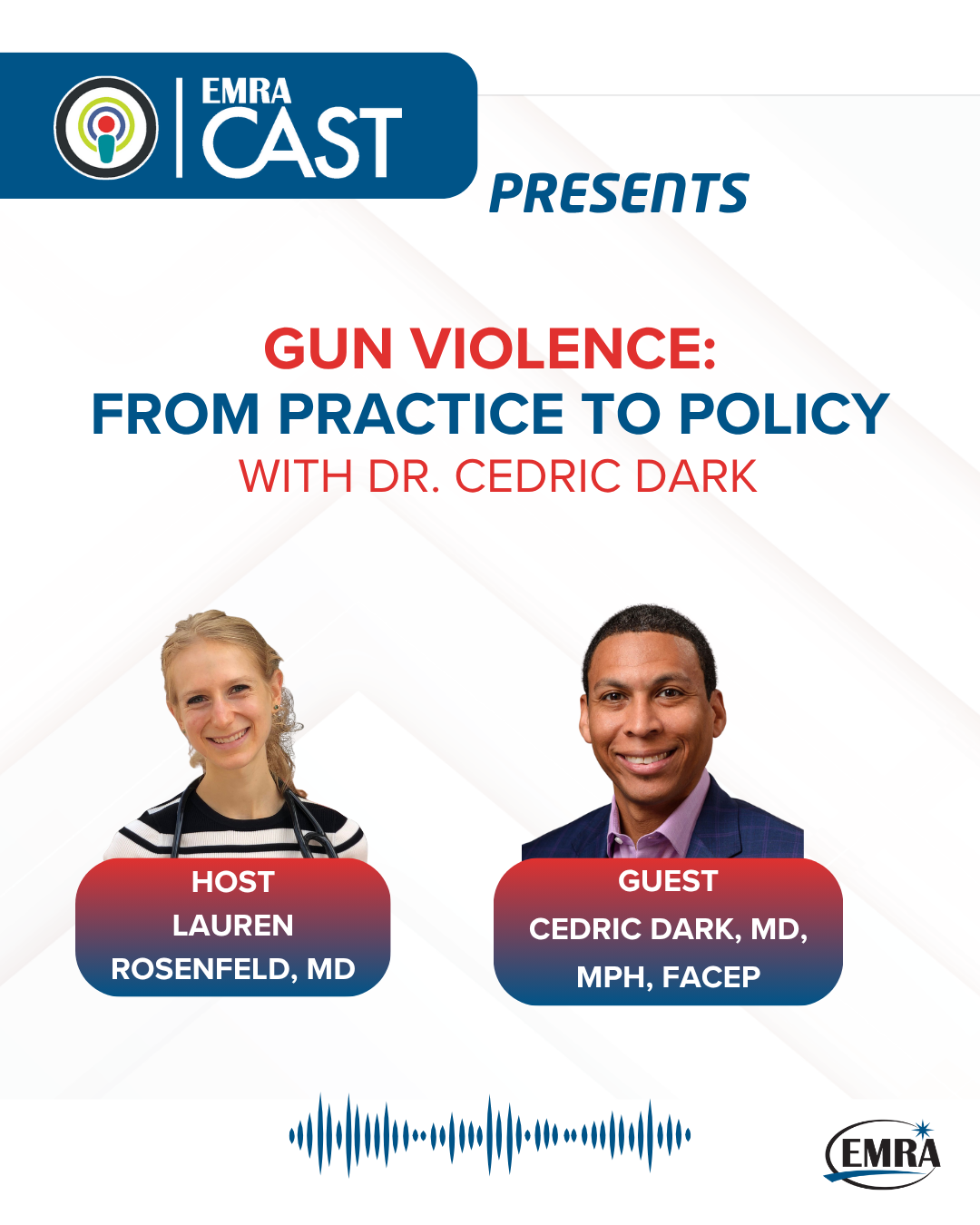Gun Violence: From Practice to Policy, with Dr. Cedric Dark
Gun Violence: From Practice to Policy, with Dr. Cedric Dark
July 1, 2025
It was the tweet heard far and wide: When the NRA claimed doctors "should stay in their lane," physicians took aim at firearm safety as a matter of public health, policy, advocacy, and patient care. EMRA*Cast host Lauren Rosenfeld, MD, dives into this issue with author and policy guru Cedric Dark, MD, MPH, FACEP.
Host
Lauren Rosenfeld, MD
George Washington University
Emergency Medicine Residency Class of 2026
@laurenatoregon on X; @laurenkrosenfeld on IG
EMRA*Cast Episodes
Guest
Cedric Dark, MD, MPH, FACEP
Associate Professor, Emergency Medicine - Baylor College of Medicine
Author, Under the Gun: An ER Doctor's Cure for America's Gun Epidemic
Associate Editor, Emergency Medicine Advocacy Handbook
Obi-Wan Kenobi of health policy and advocacy
OVERVIEW
Gun violence, widely recognized as an epidemic in America, can be effectively addressed through policy at nearly every level - from hospital protocol to organizational action within the house of medicine to all levels of government, says author and policy expert Cedric Dark, MD, MPH, FACEP.
Discussion Questions
- Why should emergency doctors be part of the conversation on gun violence?
- How do you approach a victim of gun violence?
- Do you engage the family or police?
- Is it appropriate to educate on gun reform or gun safety?
- Why highlight the discrepancy "we are not anti-guns, we are anti-bullet holes?"
- How does your work in policy inform your practice in the ED?
SUMMARY
Gun violence remains at epidemic levels in the United States, and organizations throughout the house of medicine continue to advocate for firearm injury prevention measures. Advocacy expert Cedric Dark, MD, MPH, FACEP, has authored a book, "Under the Gun: An ER Doctor's Cure for America's Gun Epidemic," with actionable ways to address this politically charged topic.
Dr. Dark has advocated for firearm safety throughout his career. But in 2018, the NRA took to social media to reprimand physicians to "stay in their lane" instead of weighing in on injury prevention. This served as a catalyst, and is also the root of the fundamental advice he offers for your own advocacy efforts: Find something that pisses you off, and try to fix it.
TAKE-HOME POINTS
- In the U.S., someone dies by firearm every 11 minutes, approximately.
- Americans are 26 times more likely to be shot and killed than others in high-income countries.
- Every day, 327 people are shot in the United States. Of those, on average, 117 will die.
- Every day, 23 minors are shot in the United States.
- Mass shootings make up only 1% of all gun violence in America.
- 60% of gun deaths are suicide
- 37% of gun deaths are homicide
- 3% of gun deaths include law enforcement-involved shootings, unintentional shootings, and those that were undetermined
- In the U.S., we have more guns than citizens and more dealers than McDonald's franchises.
- As of 2022, the United States has 121 firearms per 100 residents, making it the only country with more civilian-owned firearms than people.
- 22% of guns are sold without a background check.
- The ABCDE approach is a universal tool designed to assess and treat trauma patients: Airway, Breathing, Circulation, Disability, Exposure.
- Universal background checks, child-access prevention laws, minimum age restrictions, waiting periods, domestic-violence restraining orders, and permits to purchase rearms have all been shown to reduce the morbidity and mortality that firearms inflict.
- Primary prevention focuses on preventing gun violence before it occurs (eg, gun safety education, and promoting safe firearm storage practices).
- Secondary prevention aims to identify individuals or groups at high risk and intervene early to prevent escalation (eg, mentorship and violence intervention programs).
- Tertiary prevention focuses on individuals who have already experienced gun violence, aiming to reduce the impact and prevent future incidents (eg, counseling and victim support services).
- The EMRA Representative Council has voted repeatedly to support regulatory, legislative, advocacy, and public health efforts surrounding firearm safety and injury prevention. (See EMRA Policy Compendium, Section VI. Firearm Safety and Injury Prevention.)
- ACEP believes physicians have a public health responsibility to reduce the prevalence and impact of violence through advocacy, education, legislation, and research initiatives.
- "Find something that pisses you off and try to fix it."
Resources
- Clare D, Baxley S. An Evidence-Based Approach to Managing Gunshot Wounds in the Emergency Department (Trauma CME). EB Medicine. 2023;25(4).
- Fischer K, Joseph DA, Colwell C, et al. Trauma-Informed Care. CorePendium. June 21, 2024.
- Franke A, Bieler D, Friemert B, Schwab R, Kollig E, Gusgen C. The First Aid and Hospital Treatment of Gunshot and Blast Injuries. Dtsch Arztebl In. 2017;114(14):237-243.
- Galian D. Firearms and Emergency Department Safety. ACEP Now. Aug. 11, 2022.
- Mughal AY. Book and Media Review - Under the Gun: An ER Doctor's Cure for America's Gun Epidemic. Ann Emerg Med. 2025;85(3):293.
- Gramlich J. What the data says about gun deaths in the U.S. Pew Research Center. March 5, 2025.
- Dark C. That Patient, That Feeling You Just Can't Shake. Medpage Today. July 7, 2024.
- Cedric Dark, MD, MPH. ER Doc | Writer | Influencer | Shaker of Fists.
- Statistics: Gun Violence in America. Brady United.
- CDC. Injury and Violence Prevention.
- Ranney M. #ThisIsOurLane: Doctors push back on NRA over gun debate. CBS News. Nov. 14, 2018.
- Wamsley L. After NRA Mocks Doctors, Physicians Reply: 'This Is Our Lane.' NPR. Nov. 11, 2018.
- Magee F. Every 30 minutes, someone arrives at an ER with a gunshot wound, according to the CDC. The Trace. June 10, 2025.
- Dark C. Debating the Risks and Benefits of Firearms in the US - Make the Other Side Panicky. JAMA Network Open. 2025;8(3):e250811.
- Conversation Toolkit: Talking to Patients About Firearms (free download). MobilEM for Android. MobilEM for Apple.
For even more information, check out Dr. Dark's book: Under the Gun: An ER Doctor's Cure for America's Gun Epidemic.
Special thanks to Dr. Andy Little for his help with this episode and constant support for our EMRACast family.





